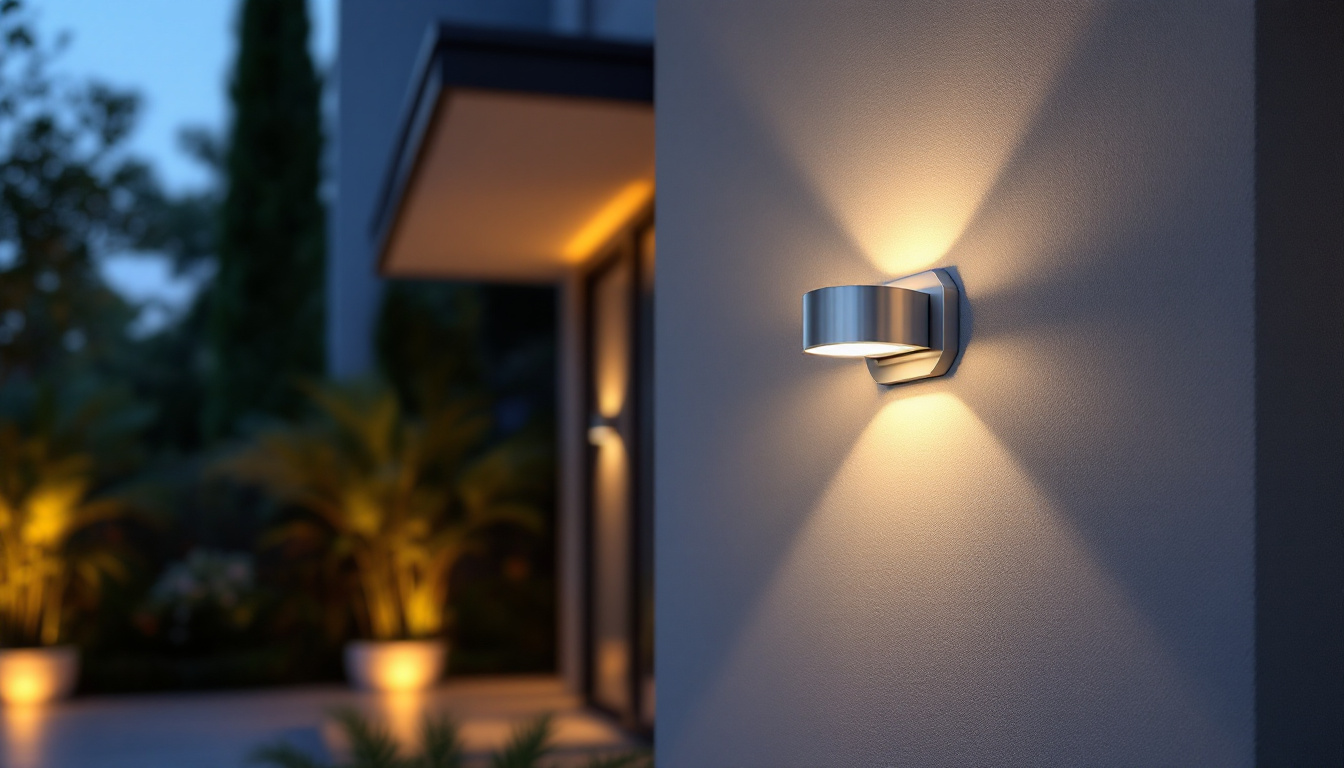
As the demand for sustainable and energy-efficient solutions continues to rise, solar lighting has emerged as a popular choice for outdoor spaces. Lighting contractors are increasingly being called upon to install solar light outdoor wall mounts, which offer a range of benefits, including reduced energy costs and minimal environmental impact. However, the installation of these systems can present unique challenges. This article explores how lighting contractors can navigate potential issues effectively.
Before diving into installation techniques, it is crucial for lighting contractors to have a solid understanding of solar lighting technology. Solar lights operate by converting sunlight into electricity, which is then stored in batteries for use during nighttime. This fundamental principle can help contractors make informed decisions during the installation process. Furthermore, advancements in solar technology, such as improved photovoltaic cells and energy-efficient LED bulbs, have significantly enhanced the performance and reliability of solar lighting systems, making them a more viable option for various applications.
Solar lighting systems typically consist of several key components: the solar panel, battery, LED light fixture, and control circuitry. Each component plays a vital role in the overall performance of the lighting system. For instance, the efficiency of the solar panel directly impacts how much energy is collected, while the battery’s capacity determines how long the lights will operate after sunset. Additionally, the control circuitry is responsible for regulating the energy flow, ensuring that the lights turn on and off at the appropriate times, which can be particularly beneficial in areas with varying daylight hours throughout the year.
Understanding these components allows contractors to select the right products for specific applications, ensuring optimal performance and longevity of the installation. For example, in regions with limited sunlight, contractors might opt for solar lights equipped with larger panels or higher-capacity batteries to maximize energy storage. This knowledge not only enhances the functionality of the lighting system but also contributes to customer satisfaction by providing reliable illumination when it is needed most.
There are various types of solar wall lights available, each designed for different applications. Some models are specifically designed for security, while others focus on aesthetic appeal. Contractors should familiarize themselves with these options to recommend the best solutions to their clients. Additionally, understanding the differences in brightness, battery life, and design will aid in making informed choices during the selection process. For instance, motion-sensor solar wall lights can provide added security by illuminating only when movement is detected, thus conserving energy while ensuring safety.
Moreover, solar wall lights come in a range of styles and finishes, allowing them to complement different architectural designs. From sleek modern fixtures to vintage lantern styles, the aesthetic choices available can enhance the visual appeal of a property while providing functional lighting. Contractors should also consider the installation environment; for example, lights designed for coastal areas may feature corrosion-resistant materials to withstand harsh weather conditions. By taking these factors into account, contractors can deliver tailored solutions that meet both the practical and stylistic needs of their clients, ultimately elevating the overall quality of their installations.
While solar lighting installations can be straightforward, several challenges may arise during the process. Being aware of these potential issues can help contractors mitigate risks and ensure a successful project.
A thorough site assessment is critical before installation begins. Factors such as shading from trees or buildings can significantly affect the performance of solar lights. Contractors should evaluate the site for optimal sunlight exposure throughout the day. If the area is heavily shaded, it may be necessary to consider alternative locations or additional lighting solutions to ensure adequate illumination.
In addition, contractors should prepare the installation site by ensuring it is free of debris and obstacles. A clean and clear area will facilitate a smoother installation process and enhance the overall aesthetic of the lighting system.
The battery is one of the most crucial components of a solar lighting system. Contractors must consider the battery type, capacity, and expected lifespan when planning an installation. Lithium-ion batteries, for example, offer longer life and better performance compared to traditional lead-acid batteries. Understanding these differences allows contractors to select batteries that will meet the specific needs of their clients.
Moreover, contractors should educate clients on the importance of regular maintenance, such as checking battery health and replacing batteries when necessary. This proactive approach can prevent future issues and ensure the longevity of the solar lighting system.
To avoid common pitfalls during installation, lighting contractors should adhere to best practices that promote efficiency and effectiveness. These practices can lead to a more successful installation and satisfied clients.
Correct mounting is essential for the optimal performance of solar lights. Contractors should follow manufacturer guidelines for mounting height and angle to maximize sunlight exposure. Generally, solar lights should be mounted at a height that allows for adequate illumination while minimizing the risk of vandalism or damage.
Additionally, using high-quality mounting hardware can enhance the durability of the installation. Weather-resistant materials are recommended to withstand various environmental conditions, ensuring that the lights remain securely in place over time.
While many solar lights are designed to be wireless, some systems may require wiring for additional features, such as remote controls or sensors. Contractors must ensure that all connections are secure and weatherproof to prevent moisture ingress, which can lead to electrical failures.
Using appropriate connectors and sealants can help protect the wiring from the elements, thereby extending the life of the lighting system. It is also advisable to test connections before finalizing the installation to ensure everything is functioning correctly.
Once the installation is complete, ongoing maintenance is essential to ensure the long-term success of solar lighting systems. Lighting contractors should provide clients with guidance on how to maintain their solar lights effectively.
Solar panels require regular cleaning to remove dirt, dust, and debris that can obstruct sunlight. Contractors should recommend a cleaning schedule to clients, especially in areas prone to pollution or dust. A simple wash with water and a soft cloth can significantly improve the efficiency of the solar panels.
In addition to cleaning, regular inspections of the entire system are vital. Contractors should encourage clients to check for any signs of wear or damage, such as loose connections or corrosion. Identifying issues early can prevent more significant problems down the line.
Despite proper installation and maintenance, issues may still arise with solar lighting systems. Contractors should be prepared to troubleshoot common problems, such as dim lighting or complete failure to turn on. Often, these issues can be traced back to battery failure, insufficient sunlight exposure, or faulty connections.
Providing clients with a troubleshooting guide can empower them to address minor issues independently. However, for more complex problems, contractors should be available to offer professional support and repairs.
Effective communication with clients is key to ensuring satisfaction and minimizing issues. Lighting contractors should take the time to educate clients about the solar lighting system, its benefits, and how to maintain it properly.
Contractors should set realistic expectations regarding the performance of solar lights. Factors such as weather conditions, geographical location, and seasonal changes can affect the efficiency of solar lighting. By discussing these variables upfront, contractors can help clients understand what to expect from their solar lighting systems.
Additionally, providing information on the expected lifespan of components, such as batteries and LEDs, can help clients plan for future maintenance and replacements.
Encouraging feedback from clients can provide valuable insights into the installation process and the performance of the solar lighting system. Contractors should create an open line of communication, allowing clients to express any concerns or issues they may encounter. This proactive approach can lead to improved customer satisfaction and enhance the contractor’s reputation.
The future of solar lighting in outdoor spaces looks promising, with advancements in technology and increasing awareness of sustainability. As more clients seek eco-friendly solutions, lighting contractors must stay informed about the latest trends and innovations in solar lighting.
New technologies, such as smart solar lights with integrated sensors and connectivity features, are becoming increasingly popular. These innovations allow for greater control over lighting patterns and energy consumption, making solar lighting even more efficient and user-friendly. Contractors should consider incorporating these technologies into their offerings to meet the evolving needs of their clients.
Moreover, as battery technology continues to improve, the performance and reliability of solar lights are expected to enhance further. Staying updated on these advancements can give contractors a competitive edge in the market.
Solar light outdoor wall mounts present a valuable opportunity for lighting contractors to provide sustainable and efficient lighting solutions. By understanding the technology, anticipating common challenges, adhering to best practices, and fostering effective communication with clients, contractors can navigate the complexities of solar lighting installations successfully.
As the industry continues to evolve, staying informed about emerging trends and technologies will be essential for contractors looking to thrive in the competitive landscape of solar lighting. With the right approach, lighting contractors can not only avoid issues but also contribute to a greener future through the implementation of solar lighting solutions.
Ready to elevate your solar lighting installations with the best products on the market? Look no further than LumenWholesale, where we provide contractors with superior, spec-grade lighting solutions at unbeatable wholesale prices. Our commitment to quality and affordability ensures that you can deliver reliable and high-performance solar light outdoor wall mounts to your clients without breaking the bank. Take advantage of our hassle-free bulk buying and free shipping to get premium lighting at the best value. Don’t let hidden fees or inflated markups dim your project’s potential. Discover wholesale lighting at the best value today and brighten your clients’ outdoor spaces with confidence and convenience.

Discover how integrating outlet switch combos can revolutionize your lighting contracting business.

Discover essential insights for lighting contractors navigating the evolving landscape of smart home automation.

Discover expert tips and best practices for installing solar lamp post lanterns in this comprehensive guide tailored for lighting contractors.

Explore the innovative strategies of smart lighting contractors in “Par Lamp: The Smart Lighting Contractor’s Approaches.” Discover how cutting-edge technology and creative solutions are transforming spaces with intelligent illumination..